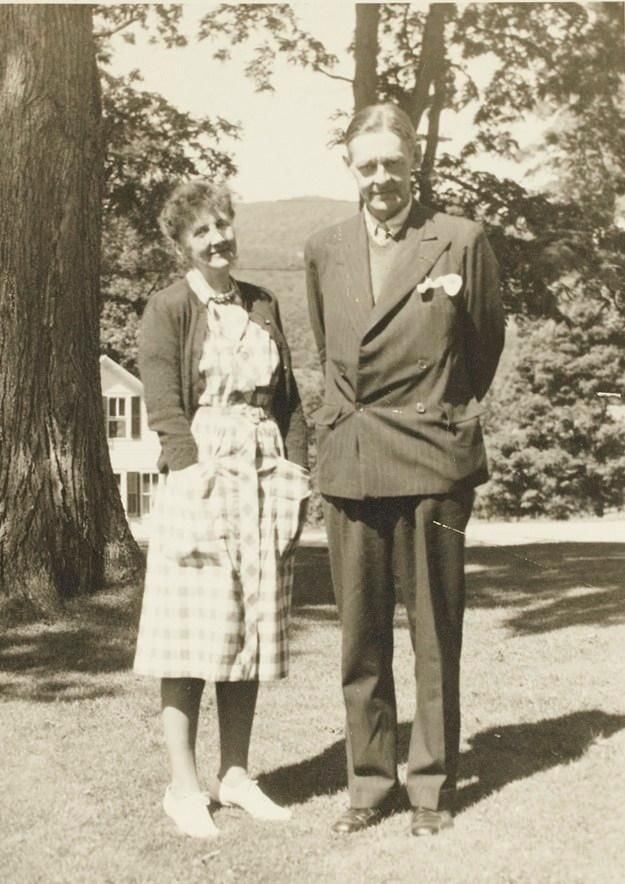Emily Hale Was T.S. Eliot’s Confidante—and More, Suggest Newly Unsealed Letters
Despite Eliot’s assertions to the contrary, the letters point to a passionate love between the duo
/https://tf-cmsv2-smithsonianmag-media.s3.amazonaws.com/filer/24/21/24212a15-b33c-419d-8d52-24a28b55760e/screen_shot_2020-01-06_at_23335_pm.png)
In 1960, T.S. Eliot penned a blistering statement about Emily Hale, a woman he’d fallen in love with decades earlier. The writer knew that Hale had given a collection of his letters to Princeton University, with instructions that the documents remain sealed until 50 years after her or Eliot’s death, depending on who survived longer. And Eliot wanted to set the record straight about their relationship.
“Upon the death of [my wife] Vivienne in the winter of 1947, I suddenly realized that I was not in love with Emily Hale,” wrote Eliot in a statement he planned to make public whenever Hale’s letters came to light.
“I had already observed that she was not a lover of poetry, certainly that she was not much interested in my poetry,” he made a point of noting. “I had already been worried by what seemed to me evidence of insensitiveness and bad taste.”
But researchers who have viewed the collection, which was released at the Princeton University Library last week, say the letters reveal a different reality. Hale is often described as Eliot’s muse and confidante, but experts have often wondered if their relationship was something more. Now, Eliot scholar Frances Dickey tells Gillian Brockell of the Washington Post, the unsealed passages leave no doubt that Eliot loved Hale.
“[H]e basically confesses his love for Emily Hale and tells her that she’s the great love of his life,” says Dickey, “that he’s been writing for her all of these years, and he even names the places in his poetry where he has paid tribute to her or honored her in some way.”
Hale taught speech and drama at various colleges. She and Eliot met in 1912, when he was a graduate student at Harvard. The pair rekindled their friendship in 1927, by which point Eliot had moved to England and married Vivienne Haigh-Wood. The 1,131 letters in Hale’s archive—which were made public five decades after her 1969 death, per her instructions—date from 1930 to 1957.
The union between Eliot and Haigh-Wood was not a happy one, and during their marriage, Eliot penned warm, passionate letters to Hale.
“You have made me perfectly happy: that is, happier than I have ever been in my life; the only kind of happiness now possible for the rest of my life is now with me; and though it is the kind of happiness which is identical with my deepest loss and sorrow, it is a kind of supernatural ecstasy,” the poet wrote in 1930, as quoted by the Guardian’s Edward Helmore.

Many scholars believe that Hale was the inspiration behind some of Eliot’s more moving verses, including “Burnt Norton” (“Footfalls echo in the memory / Down the passage which we did not take / Towards the door we never opened / Into the rose-garden.”) In the newly released letters, Dickey tells the Post’s Brockell, Eliot also calls Hale’s attention to the “hyacinth lines” in “The Waste Land”:
You gave me hyacinths first a year ago;
‘They called me the hyacinth girl.’
—Yet when we came back, late, from the Hyacinth garden,
Your arms full, and your hair wet, I could not
Speak, and my eyes failed, I was neither
Living nor dead, and I knew nothing,
Looking into the heart of light, the silence.
Oed’ und leer das Meer.
Though Eliot’s expressions of love were sometimes explicit—“I tried to pretend that my love for you was dead, though I could only do so by pretending myself that my heart was dead,” he said in one letter quoted by Helmore—he dismissed the nature of his feelings in his response to Hale’s donation of their correspondences.
“Gradually I came to see that I had been in love only with a memory, with the memory of the experience of having been in love with her in my youth,” the poet claimed.
Eliot even opined that pursuing a relationship with Hale would have stifled his creative career.
“Emily Hale would have killed the poet in me; Vivienne nearly was the death of me, but she kept the poet alive,” he wrote. “In retrospect, the nightmare agony of my seventeen years with Vivienne seems to me preferable to the dull misery of the mediocre teacher of philosophy which would have been the alternative.”
What prompted Eliot’s caustic assessment of his relationship with Hale is not entirely clear. Perhaps he did not want to appear vulnerable, Anthony Cuda, an Eliot scholar at the University of North Carolina at Greensboro, tells Maria Cramer of the New York Times. Or perhaps he wanted to shield the feelings of his second wife, Esmé Valerie Fletcher, whom he married in 1957.
Hale’s letters to Eliot do not survive; in his statement, the poet notes that they had been “destroyed by a colleague at my request.” Still, Dickey tells Brockell, Hale provided two statements of her own to accompany the archive. These comments reveal that she was “devastated” when she did not receive a marriage proposal from Eliot following Vivienne’s death.
The poet’s reframing of his creative and emotional connection to Hale is “petty” and “beneath him, really,” Dickey opines. “It’s disappointing that he felt at that late stage that he needed to disavow his relationship with Emily Hale.”